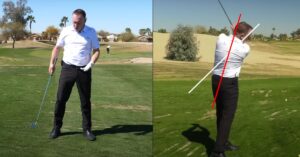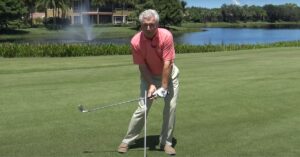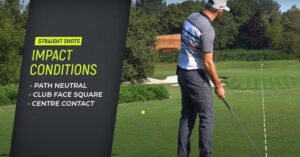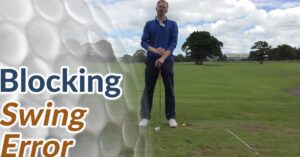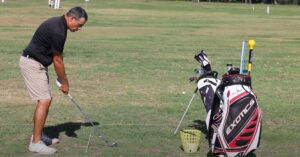How To Stop Lifting Up In Golf Downswing?
The golf downswing is a critical phase that can make or break your shot. Many golfers struggle with a common issue during their downswing: lifting up. This detrimental habit can result in poor ball contact, loss of power, and inconsistent shots.
To prevent lifting up in the golf downswing, it’s essential to focus on proper sequencing, balance, and maintaining a connected swing. The key is to initiate the downswing from the lower body, allowing the hips to lead the movement while maintaining a stable upper body position.
In this blog post, we will explore how to overcome the tendency to lift up during the golf downswing.
7 Common Reasons for Lifting Up in the Golf Downswing

Lifting up in the golf downswing refers to a common swing fault where the golfer raises the club’s path too steeply instead of maintaining a proper, downward strike.
There are several reasons why golfers may experience this issue:
1. Lack of Lower Body Engagement
Failing to initiate the downswing with the lower body is a common reason for lifting up. Instead of using the legs, hips, and lower body to drive the swing, some golfers rely too heavily on their upper body, leading to a steep and upward swing path.
2. Early Release of the Wrists
Releasing the wrists too early in the downswing can cause the clubhead to lift, resulting in a steep angle of attack. This premature release leads to a loss of lag and power, as the club fails to properly square up at impact.
3. Overactive Upper Body
When the upper body becomes too dominant in the downswing, it can lead to an over-the-top movement or casting motion. This action causes the club to lift and results in an outside-in swing path, leading to poor contact and a lack of control.
4. Improper Weight Transfer
Inadequate weight transfer from the back foot to the front foot can contribute to lifting up. Without a proper weight shift, the golfer may struggle to shallow the club and maintain a consistent swing plane, resulting in an upward motion.
5. Lack of Extension
Insufficient extension through impact can cause the golfer to stand up or lose their posture prematurely. This early extension prevents a proper downward strike and can result in a weak, high ball flight.
6. Tension and Tightness
Excessive tension and tightness in the hands, arms, and upper body can lead to lifting up.
When the muscles are too tense, the golfer may lose the ability to maintain a smooth and controlled swing, causing the club to rise instead of descending through the ball.
7. Lack of Practice and Awareness
Often, golfers may not be aware that they are lifting up during the downswing. The incorrect motion can become ingrained in their swing without regular practice and feedback, making it challenging to correct.
How To Stop Lifting Up In Golf Downswing?

Lifting up during the golf downswing is a common problem that can lead to inconsistent shots and a lack of power. Here are some steps to help you correct this issue and promote a more effective downswing:
Focus on Proper Setup and Posture
Ensure that your setup and posture are correct before starting your swing. Stand with your feet shoulder-width apart, knees slightly flexed, and your weight balanced evenly on both feet.
Maintain a straight back and tilt forward from your hips. This setup helps establish a solid foundation for your swing.
Initiate the Downswing with the Lower Body
To prevent lifting up, initiate your downswing with your lower body rather than your upper body. Begin the movement by shifting your weight onto your front foot while rotating your hips towards the target.
This transfer of weight and rotation creates a powerful and stable base for the rest of your swing.
Maintain Connection and Lag
Focus on maintaining the connection between your arms and body throughout the downswing.
Avoid the tendency to “cast” or release your wrists too early, which can lead to lifting up. Instead, maintain wrist lag, allowing the club to trail behind your hands before releasing at the correct moment for maximum power and control.
Keep Your Eyes on the Ball
One common reason for lifting up is losing focus on the ball during the downswing. Ensure that your eyes stay fixed on the ball until after impact. This helps maintain a proper swing path and promotes a more downward strike on the ball, preventing the urge to lift up prematurely.
Practice a Smooth and Controlled Tempo:
Work on developing a smooth and controlled tempo throughout your swing. Rushing or trying to hit the ball too hard often leads to lifting up.
Focus on maintaining a balanced and fluid motion, allowing the club to come down naturally and strike the ball with the proper angle of attack.
Utilize Training Aids and Drills
Consider using training aids or drills specifically designed to address the issue of lifting up in the downswing. For example, using alignment sticks or a mirror can help you visualize and correct your swing path.
Work with a golf instructor who can provide guidance and recommend drills tailored to your specific needs.
Practice Patience and Persistence
Changing ingrained swing habits takes time and persistence. Be patient with yourself and commit to regular practice sessions to reinforce the correct downswing motion.
Over time, with consistent effort, you can train your body to break the habit of lifting up and develop a more effective and powerful downswing.
Strengthening Your Golf Swing with Practice Drills

Practicing drills specifically designed to target different aspects of your golf swing can help improve your technique, consistency, and overall performance on the course.
Here are some practice drills that can help strengthen your golf swing:
Alignment And Posture Drill
Place two alignment sticks on the ground, one parallel to your target line and the other perpendicular to it.
Take your stance with your feet aligned properly and use the alignment sticks as a reference for your clubface, body alignment, and posture.
This drill helps ensure a correct setup position and promotes a square clubface at impact.
Mirror Drill For Swing Plane
Set up a mirror or use a reflective surface to observe your swing plane. Practice your swing while facing the mirror, focusing on maintaining a smooth and consistent swing path.
This drill helps you better understand your swing plane and promotes a more efficient swing motion.
Impact Bag Drill
Use an impact bag or a large duffel bag filled with towels to practice your impact position. Swing through and make contact with the bag, focusing on achieving a forward-leaning shaft, a flat left wrist (for right-handed players), and a solid impact position. This drill helps train your body to deliver a proper strike and promotes a powerful and consistent impact.
Tempo And Rhythm Drill
Developing a smooth and consistent tempo is crucial for a well-executed golf swing. Practice swinging with a metronome or counting in your head to establish a consistent rhythm.
Focus on maintaining a balanced and controlled motion throughout your swing, with a smooth transition from backswing to downswing. This drill helps improve your timing and promotes a more synchronized swing.
Weight Transfer Drill
Place an alignment stick or a club on the ground just outside your right foot (for right-handed players). As you swing, focus on shifting your weight and rotating your hips to initiate the downswing, while ensuring your left side clears the stick on the ground. This drill helps promote proper weight transfer and a more powerful downswing.
One-Handed Drill
Practice swinging with only your lead hand (left hand for right-handed players) and then your trail hand (right hand for right-handed players).
This drill helps improve your hand and arm coordination, as well as your overall swing control. It also promotes a better understanding of the role each hand plays in the swing.
Target Practice Drill:
Set up targets at different distances and aim to consistently hit those targets with your shots. Start with shorter distances and gradually increase the challenge.
This drill helps improve your accuracy and focus, as well as your ability to transfer your practice skills to the course.
Frequently Asked Questions
Whether you’re struggling with this common problem or seeking to enhance your swing, this collection of questions and concise answers will provide valuable guidance and insights.
Can Posture And Setup Affect Lifting Up In The Golf Downswing?
Absolutely. Proper posture and setup can significantly impact the golf downswing. Ensure a balanced stance, spine alignment, and proper distance from the ball.
These elements provide a solid foundation for a more consistent and controlled swing.
Is It Necessary To Work With A Golf Instructor To Fix The Issue Of Lifting Up In The Golf Downswing?
While it is possible to self-diagnose and correct lifting up in the golf downswing, working with a qualified golf instructor can expedite the process.
An instructor can offer personalized guidance, identify specific swing flaws, and provide tailored drills for improvement.
Can Strengthening Exercises Help Prevent Lifting Up In The Golf Downswing?
Yes, strengthening exercises targeted at the core, lower body, and golf-specific muscles can enhance stability and control during the downswing.
Incorporating exercises like squats, lunges, rotational movements, and resistance training can contribute to a more stable swing.
How Long Does It Take To Stop Lifting Up In The Golf Downswing?
The time required to eliminate lifting up in the golf downswing varies for each individual. It depends on factors such as the severity of the issue, commitment to practice, and consistency in implementing corrective techniques.
Improvement can be achieved with dedicated effort and repetition.
Conclusion
Remember, breaking the habit of lifting up in the golf downswing requires patience, practice, and conscious effort. Regularly incorporate these tips into your training routine and seek professional guidance if needed.
By mastering the correct downswing mechanics and staying connected throughout the swing, you’ll experience improved ball striking, consistency, and overall performance on the golf course.

